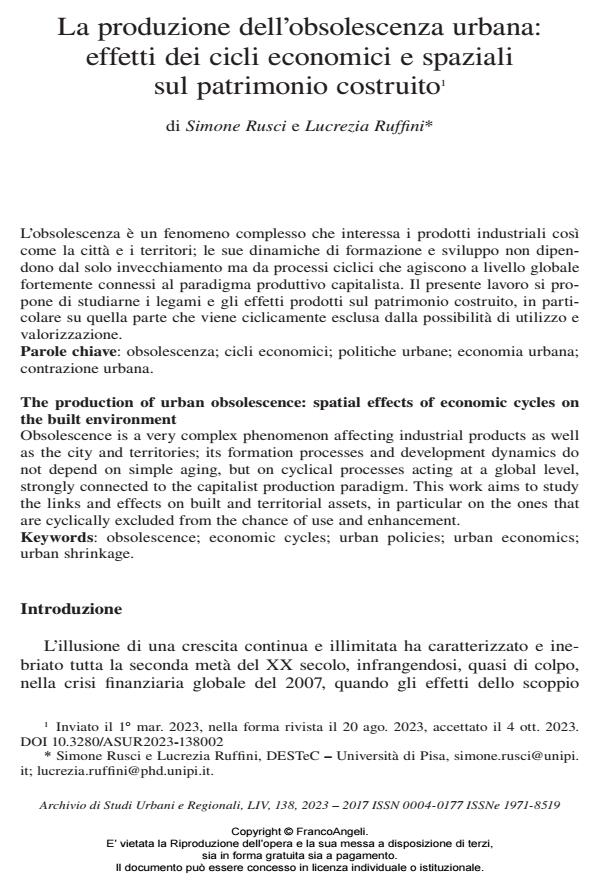The production of urban obsolescence: spatial effects of economic cycles on the built environment
Journal title ARCHIVIO DI STUDI URBANI E REGIONALI
Author/s Simone Rusci, Lucrezia Ruffini
Publishing Year 2024 Issue 2023/138 Language Italian
Pages 21 P. 29-49 File size 560 KB
DOI 10.3280/ASUR2023-138002
DOI is like a bar code for intellectual property: to have more infomation
click here
Below, you can see the article first page
If you want to buy this article in PDF format, you can do it, following the instructions to buy download credits

FrancoAngeli is member of Publishers International Linking Association, Inc (PILA), a not-for-profit association which run the CrossRef service enabling links to and from online scholarly content.
Obsolescence is a very complex phenomenon affecting industrial products as well as the city and territories; its formation processes and development dynamics do not depend on simple aging, but on cyclical processes acting at a global level, strongly connected to the capitalist production paradigm. This work aims to study the links and effects on built and territorial assets, in particular on the ones that are cyclically excluded from the chance of use and enhancement.
Keywords: obsolescence; economic cycles; urban policies; urban economics; urban shrinkage.
- Arnold L.G. (2002). Business Cycle Theory. Oxford: Oxford University Press.
- Audirac I., Cunningham-Sabot C., Fol S. and Torres Moraes S. (2012). Declining suburbs in Europe and Latin America. International Journal of Urban and Regional Research, 36(2): 226-244.
- Bartels B., Ermel U., Sandborn P. and Pecht M.G. (2012). Strategies to the prediction, mitigation and management of product obsolescence. Hoboken, New Jersey: John Wiley & Sons.
- Bolton R.P. (1911). Building for Profit: Principles Governing the Economic Improvement of Real Estate. New York: De Vinne.
- Buitelaar E., Moroni S. and De Franco A. (2021). Building obsolescence in the evolving city. Reframing property vacancy and abandonment in the light of urban dynamics and complexity. Cities, 108: 102964.
- Camagni R. (1998). Principi di economia urbana e territoriale. Roma: Carocci.
- Cao H. and Folan P. (2012). Product life cycle: the evolution of a paradigm and literature review from 1950-2009. Production Planning & Control, 23(8): 641-662. DOI: 10.1080/09537287.2011.577460
- Castells M. (1996). The Rise of the Network Society. Oxford: Blackwell.
- Champion T. (2001). Urbanization, suburbanization, counterurbanization and reurbanization. In: Paddinson R., ed., Handbook of urban studies. London: Sage. DOI: 10.4135/9781848608375
- Cutini V. and Rusci S. (2014). Urban Regeneration by Law. Towards the Definition of an Uncertain Term. Advanced Engineering Forum, 11: 297-302.
- De Rossi A. (2018). Riabitare l’Italia. Le aree interne tra abbandoni e riconquiste. Roma: Donzelli. Eurofound (2023). European Reshoring Monitor. https://reshoring.eurofound.
- europa.eu Evans A.W. (1985). Urban Economics: An Introduction. Oxford: Basil Blackwell. Gulick L. (1956, December). Five Challenges in Todays New Urban World.
- American City, 71(12): 147. Harvey D. (2018). Geografia del Dominio. Capitalismo e produzione dello spazio. Verona: Ombre corte. Indovina F. e Calabi D. (1973). Sull’uso capitalistico del territorio. Archivio di studi urbani e regionali, IV(2): 3-20.
- Kondratiev N.D. and Stolper W.F. (1935). The Long Waves in Economic Life. The Review of Economics and Statistics, 17(6): 105-115. DOI: 10.2307/1928486
- Kuhn T.S. (1970). The Structure of Scientific Revolution. Chicago: The University of Chicago Press. Levitt T. (1965). Exploit the product life cycle. Harvard Business Review, 43(6): 81-94.
- Pallagst K., Wiechmann T. and Martin-Fernandez C. (2014). Shrinking Cities. International Perspectives and Policy Implications. New York: Routledge. Peace P. and Stanback T.M. (1991). The New Suburbanization. New York:
- Routledge. Roberts P. and Sykes H. (2000). Urban Regeneration. A Handbook. London: Sage. Ruffolo G. (2001). I paradossi della crescita nell’era del turbocapitalismo. Lettera Internazionale, 67(1), 20-27.
- Rusci S. (2017). La rigenerazione della rendita. Teorie e metodi per la rigenerazione urbana attraverso la rendita differenziale. Milano: Mimesis. Rusci S. (2021). La città senza valore. Dall’urbanistica dell’espansione
- all’urbanistica della demolizione. Milano: FrancoAngeli.
- Rusci S. e Perrone M.A. (2020). The city to be demolished. A case study for the analysis of demolition and urban contraction costs in Italy. Valori & Valutazioni, 26: 59-71. DOI: 10.48264/VVSIEV-20202606
- Schumpeter J. (1935). The Analysis of Economic Change. The Review of Economics and Statistics, 17(4): 2-10. DOI: 10.2307/1927845
- Shafiee M. (2015). Maintenance strategy selection problem: an MCDM overview. Journal of Quality in Maintenance Engineering, 21(4), 378-402. DOI: 10.1108/JQME-09-2013-0063
- Thomsen A. and van der Flier K. (2011). Obsolescence and the end of life phase of buildings. Management and Innovation for Sustainable Built Environment.
- van den Berg L., Drewett R., Klaassen L.H., Rossi A. and Vijverberg C.H. (1982). Urban Europe: A Study of Growth and Decline, Volume 1. Oxford: Pergamon Press Ltd.
- Vernon R. (1966). International Investment and International Trade in the Product Cycle. Quarterly Journal of Economics, 80: 190-207. DOI: 10.2307/1880689
- Vicari Haddok S. e Moulaert F. (2009). Rigenerare la città. Bologna: il Mulino.
- Ward C.D. and Sohns C.W. (2011). Electronic component obsolescence. IEEE Instrumentation & Measurement Magazine, 14(6): 8-12. DOI: 10.1109/MIM.2011.6086892
- Zanfi F., Daglio L., Perrone A. e Rusci S. (2021). Bonus edilizi: diversificazione e integrazione con politiche urbane e territoriali. In: Coppola A., Del Fabbro M., Lanzani A., Pessina G. e Zanfi F., a cura di, Ricomporre i divari. Politiche e progetti territoriali contro le disuguaglianze e per la transizione ecologica. Bologna: il Mulino.
Simone Rusci, Lucrezia Ruffini, La produzione dell’obsolescenza urbana: effetti dei cicli economici e spaziali sul patrimonio costruito in "ARCHIVIO DI STUDI URBANI E REGIONALI" 138/2023, pp 29-49, DOI: 10.3280/ASUR2023-138002